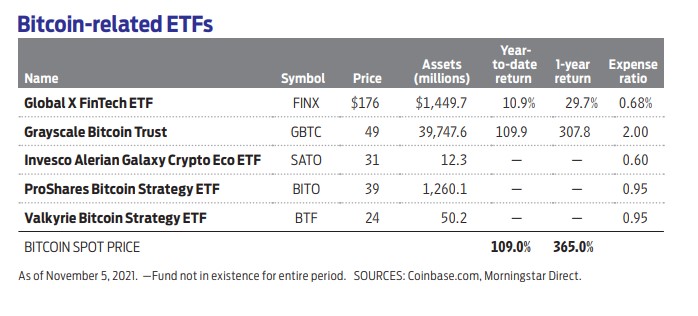New Ways to Invest in Bitcoin
ProShares Bitcoin Strategy and other ETFs offer an easier way to gain bitcoin exposure than buying the actual cryptocurrency.


The launch of an exchange-traded fund (ETF) based on bitcoin futures in October was epic. Less than a month after it opened, ProShares Bitcoin Strategy ETF (BITO) had $1.26 billion in assets – one of the biggest ETF debuts ever. A second bitcoin futures fund, Valkyrie Bitcoin Strategy ETF (BTF), opened two days after the ProShares fund.
The bitcoin futures ETFs are actively managed and use similar strategies. The managers buy one-month forward futures contracts – the nearest-dated contract – tied to bitcoin prices. Every month, they close or sell those contracts before they expire and buy new contracts dated for the next month.
You can't actually invest in bitcoin's spot price –the price at which an asset can be bought or sold for immediate delivery – says Simeon Hyman, head of investment strategy at ProShares. "So the futures market is a good place to get bitcoin exposure," he says. Because of the way futures contracts are sold, a certain amount of cash per contract needs to be held in collateral. That's why these ETFs are heavy in Treasuries and cash.
From just $107.88 $24.99 for Kiplinger Personal Finance
Become a smarter, better informed investor. Subscribe from just $107.88 $24.99, plus get up to 4 Special Issues

Sign up for Kiplinger’s Free Newsletters
Profit and prosper with the best of expert advice on investing, taxes, retirement, personal finance and more - straight to your e-mail.
Profit and prosper with the best of expert advice - straight to your e-mail.
Both ProShares and Valkyrie examined how their respective futures-based strategies would have performed in the past, relative to the spot price of bitcoin, and found a high correlation – a so-called beta of 0.87 to 0.99 – between the two. For context, S&P 500 index funds typically have a beta of 1.0 with the stock benchmark.
But futures investing comes with some unique risks. Because of how these securities are priced, shifts in supply and demand for the underlying asset – in this case, bitcoin – can impact contract prices and the fund's returns.
ETFs also have limits on the amount of any given contract they can own, says Steven McClurg, Valkyrie Funds' chief investment officer. Funds with sizable assets may be forced to purchase longer-dated futures contracts, and that can increase volatility. In early November, for instance, ProShares' BITO held November and December contracts.
Even so, the ETFs offer an easier way to gain bitcoin exposure than buying the actual cryptocurrency. You don't have to open a digital currency exchange account or remember any passwords. But if you plan to invest, devote only a small portion of your portfolio to this kind of futures ETF.
There are other ways to gain exposure to bitcoin and blockchain, the technology behind the digital asset. Invesco Alerian Galaxy Crypto Economy ETF (SATO) focuses on companies that enable the crypto economy, such as Canaan (CAN), a Chinese maker of servers and microprocessors used to create bitcoin. Grayscale Bitcoin Trust (GBTC) has yet another approach: Every share in the trust is backed by bitcoin.

Profit and prosper with the best of Kiplinger's advice on investing, taxes, retirement, personal finance and much more. Delivered daily. Enter your email in the box and click Sign Me Up.

Nellie joined Kiplinger in August 2011 after a seven-year stint in Hong Kong. There, she worked for the Wall Street Journal Asia, where as lifestyle editor, she launched and edited Scene Asia, an online guide to food, wine, entertainment and the arts in Asia. Prior to that, she was an editor at Weekend Journal, the Friday lifestyle section of the Wall Street Journal Asia. Kiplinger isn't Nellie's first foray into personal finance: She has also worked at SmartMoney (rising from fact-checker to senior writer), and she was a senior editor at Money.
-
 The Santa Claus Rally Officially Begins: Stock Market Today
The Santa Claus Rally Officially Begins: Stock Market TodayThe Santa Claus Rally is officially on as of Wednesday's closing bell, and initial returns are positive.
-
 How to Leave Different Amounts to Adult Children Without Causing a Rift
How to Leave Different Amounts to Adult Children Without Causing a RiftHere’s how to leave different amounts to adult children without causing a family rift.
-
 My Retirement Learning Curve, 1 Year In
My Retirement Learning Curve, 1 Year InA retiree checks in with what they wish they knew early on and what they've changed about their plan one year in.
-
 The Santa Claus Rally Officially Begins: Stock Market Today
The Santa Claus Rally Officially Begins: Stock Market TodayThe Santa Claus Rally is officially on as of Wednesday's closing bell, and initial returns are positive.
-
 'Humbug!' Say Consumers, Despite Hot GDP: Stock Market Today
'Humbug!' Say Consumers, Despite Hot GDP: Stock Market Today"The stock market is not the economy," they say, but both things are up. Yet one survey says people are still feeling down in the middle of this complex season.
-
 Stocks Rise to the Spirit of the Season: Stock Market Today
Stocks Rise to the Spirit of the Season: Stock Market TodayInvestors, traders and speculators are beginning to like the looks of a potential year-end rally.
-
 Nasdaq Leads as Tech Stages Late-Week Comeback: Stock Market Today
Nasdaq Leads as Tech Stages Late-Week Comeback: Stock Market TodayOracle stock boosted the tech sector on Friday after the company became co-owner of TikTok's U.S. operations.
-
 Cooler Inflation Supports a Relief Rally: Stock Market Today
Cooler Inflation Supports a Relief Rally: Stock Market TodayInvestors, traders and speculators welcome much-better-than-hoped-for core CPI data on top of optimism-renewing AI earnings.
-
 Nasdaq Sinks 418 Points as Tech Chills: Stock Market Today
Nasdaq Sinks 418 Points as Tech Chills: Stock Market TodayInvestors, traders and speculators are growing cooler to the AI revolution as winter approaches.
-
 Stocks Chop as the Unemployment Rate Jumps: Stock Market Today
Stocks Chop as the Unemployment Rate Jumps: Stock Market TodayNovember job growth was stronger than expected, but sharp losses in October and a rising unemployment rate are worrying market participants.
-
 Stocks Struggle Ahead of November Jobs Report: Stock Market Today
Stocks Struggle Ahead of November Jobs Report: Stock Market TodayOracle and Broadcom continued to fall, while market participants looked ahead to Tuesday's jobs report.